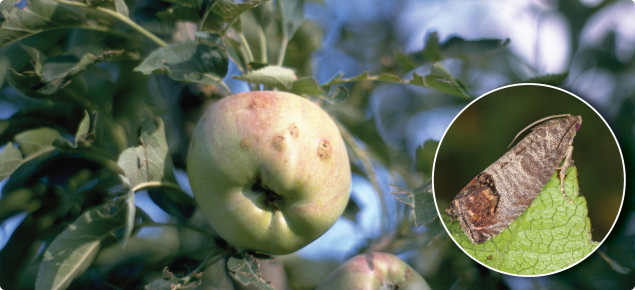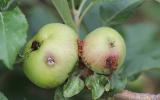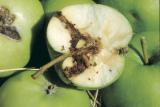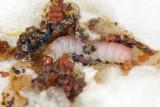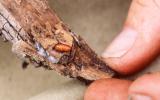What plants are affected?
- Apple, pears, quince, nashi, crab-apple, and walnuts are primary hosts with some other fruits affected.
- Apple varieties harvested late in the season including Pink Lady™ and Sundowner™, are particularly susceptible.
What do I look for?
- Worm-like larvae, 15-19mm long, white to light pink with a dark brown head.
- Shallow entry holes or 'stings' on fruit with one or more holes in fruit plugged with reddish-brown droppings (frass).
- Deep tunnels through the flesh and core of the fruit filled with frass.
- Brownish grey moths, 9mm long, with a dark, iridescent coppery-brown band at the tip of the upper wings
How does the pest survive and spread?
- Apple variety and fruit maturity influence female moths preferences to lay eggs.
- Eggs are laid on leaves and fruit surfaces and can be spread with infested plants.
- Newly hatched larvae chew through the fruit skin and bore their way to the core to feed on seeds and flesh.
- It overwinters as full-grown larvae in silken cocoons under crevices of the bark and in soil or within debris around the base of the tree.
- Larva and moth development depend on temperature with warmer springs resulting in higher codling moth populations.
- Codling moths can survive on neglected apple and pear trees, in cocoon-infested fruit bins or dumped apples around orchards or farms sheds.
- Larva can be spread in apples carried inside backpacks, luggage, personal belongings, and vehicles.
What damage can this pest cause
- Codling moth larvae can damage almost an entire crop if not controlled.
- Damage from stings make fruit unmarketable.
- Interior breakdown of tissue by bacteria in the fruit can cause premature drop.
- Stored fruit in contact with contaminated fruit are susceptible to rot.
Status in Western Australia
Codling moth (Cydia pomonella) is absent from Western Australia and is a quarantine pest. It is a prohibited organism under section 12 of the Biosecurity and Agriculture Management Act 2007.
Western Australia's Pest Freedom of codling moth is supported by general and specific surveillance, and specific import requirements to prevent its entry. A person who finds or suspects the presence of codling moth in orchards, nurseries, and urban areas or in loose fruit must report it to DPIRD.
What do I do if I find it?
Early detection and eradication will help protect Western Australia’s fruit production and nursery industries. If you find or suspect plants with codling moth, please make a report using MyPestGuide® Reporter or contact the Pest and Disease Information Service (PaDIS) to report this pest. Do not move, compost, or dispose of suspect infected fruit.
Report your observations
 | MyPestGuide® Reporter Pest and Disease Information Service |

